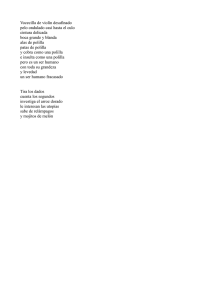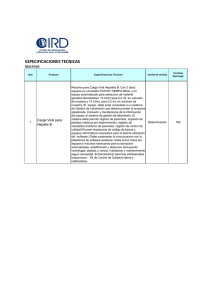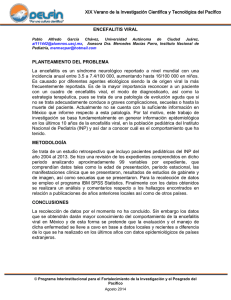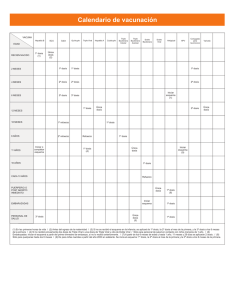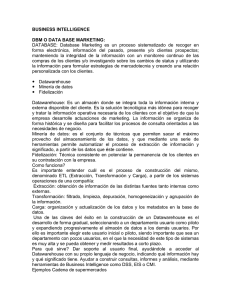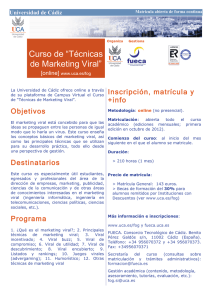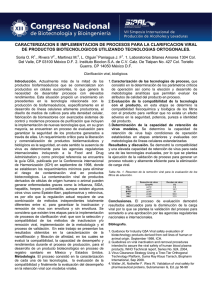Estudios preliminares sobre la patología viral de Tecia solanivora
Anuncio
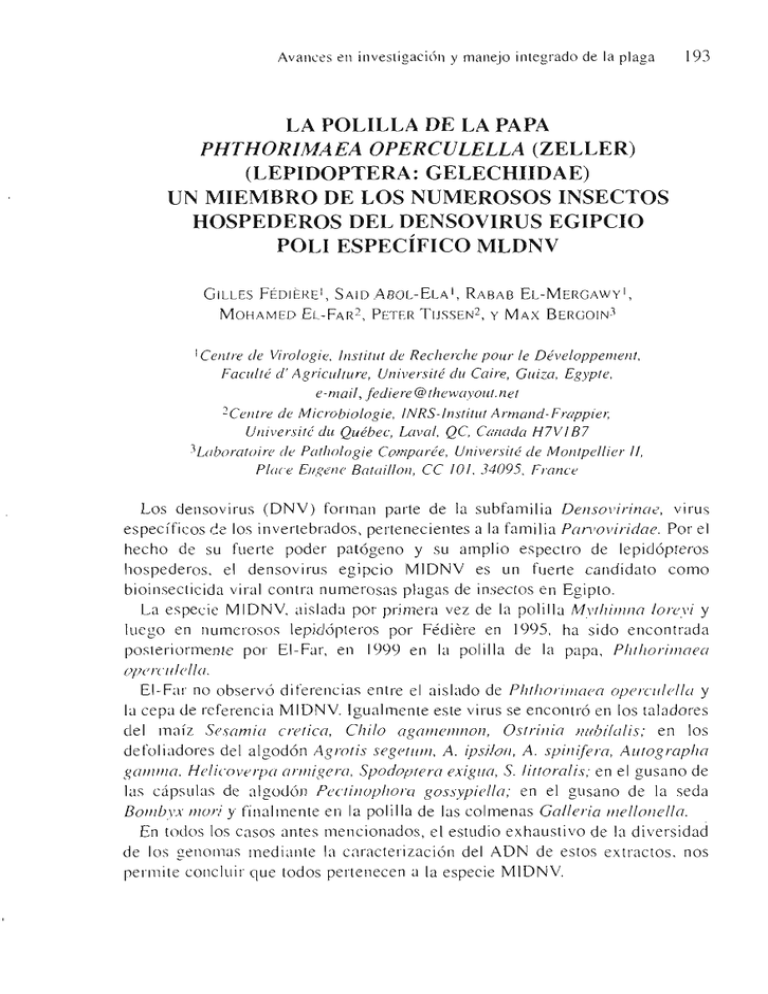
Avances èn invèsligacion y manejo inlegrado de la plaga 193 LA POLILLA DE LA PAPA PHTHORIMAEA OPERCULELLA (ZELLER) (LEPIDOPTERA: GELECHIIDAE) UN MIEMBRO DE LOS NUMEROSOS INSECTOS HOSPEDEROS DEL DENSOVIRUS EGIPCIO POLI ESPECIFICO MLDNV GILLES fÉDIÈJŒI, SAID ASOL-ELA 1 , RASAS EL-MERGAWyl, MOHAMED EL-FAR2, PETER TIJSSEN2, y MAX BERGOIN' 1Cenlre de Virologie, Inslillll de Recherche pour le Développemenl, Facullé d' Agricullure, Universilé du Caire, Guiza, Egyple, [email protected] 2Celllre de Microbiologie, INRS-inslillll Armand-Froppiel; Universilé du Québec, Laval, QC, Canada H7V 1B7 'Loboraloire de Palhologie Comparée, Universilé de Monlpel/ier Il, Plille Eugenc BOli/illon, CC 101, 34095, France Los densovirus (DNV) forman parte de la subfamilia DensoFirinoe, virus especfficos los invertebrados, pertenecientes a la familia Pan'oFiridae. Par el hecho de su fllerte poder pat6geno y su amplio espectro de lepid6pteros hospederos, el densovirus egipcio MIDNV es un fuerte candidato como bioinseclicida viral contra numerosas pl agas de insectos en Egipto. La especic MI DNV, aislada por pri mera vez de la pol i lia M"lhillllla lorCl'i y 11Icgo en numcrosos lepid0l'teros por Fédière en 1995, ha sido encontrada posleriormenle par El-Far, en 1999 en la polilla de la papa, Phl!lOrimaeo upaclI!el!o. El-Far no observo diferencias entre el aislado de Phl!WI'III/{/c{[ opcrclIlcl/o y la cepa de rcferencia MIDNV, Igualmente este virus se encontro en los taJadores dei maÎz Sesamia crelica, Chi/o agmlJclllnon, OSlrillia IIlIbilalis: en los defoliadores dei algodon Agrolis sege/l/lll, A. ipsiloll, A. spinifem, AUlograp!w g 0111 ilia, Helicovl:'rpa ol'llligera, Spodoplera exigl/o, S. lil/oralis: en el gusano de las câpsllias de algod6n PcclillUp!101'a gossypiella; en el gllsano de la seda BOlllbyx lIIuri y fillalmente ell la polilla de las colmenas Galleria lIIellol/cl/a. En todos los GISOS antes mencionados, el estlldio exhaustivo de la diversidad de los gellomas mediante la caracterizaci6n dei ADN de estos extractos, nos l'ermite COl1clllir que todos pertenecen a la especie MIDNV, ce 194 Il Taller Internacional de polilla guatemalteca Tecia so/anivora Utilizando varias técnicas como ensayos PCR (Polymerase Chain Reaction) (Reacc i6n en Cadena de la Pol i merasa), sondas nucleicas, clonaje y también con la secuenciaci6n de estos diferentes genomas, clasificamos en un aislado simple cuando no existfa ninguna diferencia nucleotfdica 0 en cepa cuando se observaron mutaciones puntuales, sin cambios en la organizaci6n gen6mica. Este tipo de resuJtados nos ayudan a conocer si las eventuales diferencias en virulencia de un aislado viral, con respecto a otros que afectan a poblaciones geogrâficas 0 ecol6gicas de lepid6pteros de la misma u otras especies, corresponden a aislados virales genéticamente distintos. Estos resultaclos nos Ilevarân a identificar la diversidad viral de los densovirus. Palabras claves: Densovirus; Egipto; Lucha biol6gica: Papa; Phthorilllaea operculella THE POTATO TUBER MaTH PHTHORIMAEA OPERCULELLA (ZELLER) (LEPIDOPTERA: GELECHIIDAE) A MEMBER OF THE LARGE HOST RANGE EGYPTIAN DENSOVIRUS MLDNV Densoviruses (DNV) are part of the Densovirinae subfamily, specific vlruses of the invertebrates, which belong to the PanJoviridae family. Due to their high pathogenicity and their wide range of lepidopterous hosts, the Egyptian densovirus MIDNV is a strong candidate for viral bio-inseclicide against numerous inseci pesls in Egypt. The species MIDNV, firsl isolatecl l'rom the moth Mythimma loreyi and then in numerous Lepidoptera by Fédière in 1995, has been further studied by El-Far in 1999 in the potato tuber moth El-Far did not observe any differences between the isolate From Plllhorinw('a operculella and the MIDNV reference stock. Likewise, the virus was found in corn borers such as Sesamia cretica, Chilo agamemnon and OSlrinia nubilali.\: in collon defoliators such as Agrotis segetum, A. ipsilon, A. spinifera. AUlOgrap/w gamma, Helicaverpa armigera, Spadaptera exiRua and S. littoratis: in the Cotton-Boil Worm Pectinaphora gassypiella: in the Silkworm Bombyx mari; and in the Greater Wax moth Galleria mel/onello, The thorough study of the genomic diversity by means of the DNA characterization of these extracts in ail the aforementioned cases brings us to the conclusion that ail of them belong to the same MIDNV species. Avances en invesligaci6n y manejo integrado de la plaga 195 In fact. by using varied techniques such as PCR (Polymerase Chain Reaction) trials. nucleic probes. cloning, and sequencing of these differenl genomes, we classified [hem inlo a simple isolate when no nucleotide difference is found, and into a slOck when punctual mutations (without alterations of the genomic organizalion) are observed. This kind of results heJp us to learn if the eventual viral differences of an isolate, regarding geographic or ecological populations of lepidopterous of the same species or of another species, correspond to genetically viral isolates. These results allow us to precisely determine the viral diversity in densoviruses. Key words: Biological struggle; Densovirus; Egypt; Phthorimaea operculella; Potato

